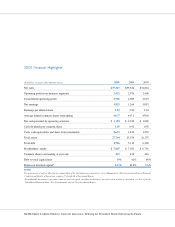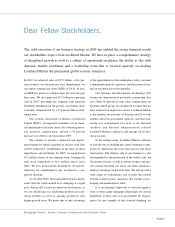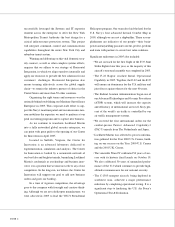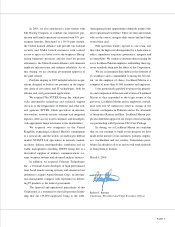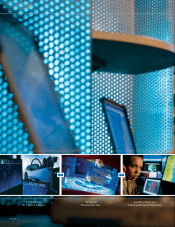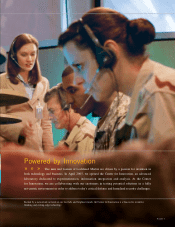Lockheed Martin 2005 Annual Report Download - page 5
Download and view the complete annual report
Please find page 5 of the 2005 Lockheed Martin annual report below. You can navigate through the pages in the report by either clicking on the pages listed below, or by using the keyword search tool below to find specific information within the annual report.
PAG E 3
Facing Page: Robert J. Stevens, Chairman, President and Chief Executive Officer
Dear Fellow Stockholders,
The solid execution of our business strategy in 2005 has yielded the strong financial results
our stockholders expect from Lockheed Martin. We have in place a comprehensive strategy
of disciplined growth as well as a culture of operational excellence, the ability to flex with
dynamic market conditions and a leadership team that is focused squarely on making
Lockheed Martin the preeminent global security enterprise.
In 2005, we achieved sales of $37.2 billion, a five per-
cent increase over the previous year. Significantly, we
can report earnings per share (EPS) of $4.10. In fact,
our EPS has grown at a double-digit rate over the past
four years. We also generated $3.2 billion in operating
cash in 2005, providing this company with financial
flexibility. Rounding out the picture, our balance sheet
is healthy, demonstrated by a 39 percent debt-to-total-
capital ratio.
Our revised calculation of Return on Invested
Capital (ROIC), an important barometer of our finan-
cial performance and a key metric for evaluating execu-
tive incentive compensation, showed a 34 percent
increase over 2004 to 14.5 percent in 2005.
We continue to execute a balanced cash deploy-
ment strategy by which a majority of our free cash flow
will be returned to stockholders in the form of share
repurchases and dividends. In 2005, we repurchased
19.7 million shares of our common stock, bringing the
total stock repurchase to 46.1 million shares since
2002. We also increased the dividend by 20 percent,
reflecting our commitment to pay an attractive, com-
petitive dividend.
As we enter 2006, this management team is keenly
aware that the world around us is changing at a rapid
pace. Sitting still is never an option in our business, so
we are solidifying our leadership position in tradi-
tional markets as well as gaining ground in new
higher-growth areas. We know that to take advantage
of the opportunities in the marketplace today, customer
commitments must be a priority, and that means focus-
ing on execution across the portfolio.
Our Systems and Information Technology (IT)
businesses demonstrated particular momentum this
year. With 50 percent of total sales coming from our
Systems and IT group, we are pleased to report that we
have achieved an impressive record. Lockheed Martin
is the number one provider of Systems and IT to both
defense and civil government agencies, and that lead-
ership was strengthened last year as the National
Archives and Records Administration selected
Lockheed Martin to preserve and manage all its elec-
tronic records.
In the defense arena, Lockheed Martin continues
to lead the way in building net-centric battlespace oper-
ations by delivering the tools that process and share
information. The defense side of our business is also
distinguished by the production of the world’s only 5th
Generation aircraft, as well as advanced space and mis-
sile systems that help our forces and allies maintain a
military advantage on the front lines. We also provide a
wide range of technologies and systems that extend
beyond combat power—missions that include peace-
keeping and humanitarian relief.
It is increasingly important to envision applica-
tions of these game-changing technologies for critical
homeland security and civil government IT require-
ments. In one example of this forward thinking, we


